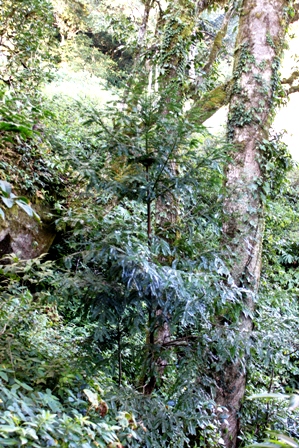PanNature, in collaboration with the Kbang District Agricultural Service Center…

A community of endangered conifers found in Xuan Nha Nature Reserve
During a field survey in the middle of December 2012 PanNature’s research team discovered an area near Pha Luong peak in Xuan Nha Nature Reserve (Son La province) where several precious and rare coniferous tree species are thriving. These conifers include Plum Yew (Cephalotaxus mannii) and two species of Catkin Yew (Amentotaxus).
The investigation in Xuan Nha Reserve is a part of the project “Conservation of conifer tree species in Hoa Binh – Son La limestone corridor” implemented by PanNature and supported by the Rufford Small Grants.
The forest area is about 120 hectares, locating in the southwest slope of Pha Luong mountain (at altitude 1,580 -1,635 m) in the boundary of Cot Moc village (Tan Xuan commune, Moc Chau district, Son La province) and adjacent to Xam Neua district (Lao PDR). There is a mixed subtropical mountainous forest grown on sandstone. Three rare conifer species were found in this area, including Cephalotaxus mannii, Amentotaxus argotaenia and Amentotaxus yunnanensis.
The population of Cephalotaxus mannii in Pha Luong consists of 10 mature trees. Some of them reach 25m in height and 0.8 m in diameter. Trees growing on rock cliffs of the mountain are usually smaller, with main stems broken and many side branchlets. The team also found dozens of young seedlings of Cephalotaxus mannii well regenerating on moist humus layer of the forest.
Bark of Cephalotaxus mannii trees has brown-red color, peeling away into thin layers. The upper side of its leaves is dark green while the underside has white stomatal bands. Cephalotaxus mannii is scatteredly distributed in Vietnam. Its current conservation status is listed as Vulnerable (VU) in both Vietnam Red Data Book (2007) and IUCN Red List. The species is also included in the Appendix IIA of the Decree 32 of Government of Vietnam on Management of Endangered, Precious, and Rare Species of Wild Plants and Animals.

A sapling of Cephallotaxus mannii in Pha Luong mountain
In the same area where the population of Cephalotaxus grows, the research team also found a big tree of Amentotaxus yunnanensis. It has a large trunk, with diameter 85 cm and height approximate 30 m. Amentotaxus yunnanensis is a very rare conifer listed as endangered (EN) in the IUCN Red List. It is normally found on limestone areas in Ha Giang, Lao Cai, Bac Kan, Tuyen Quang provinces. In Pha Luong, the tree just grows on the sandstone-derived clay soil and has an unusual large size. In the past, a similar tree of Amentotaxus yunnanensis with the same size was found in Pu Luong Nature Reserve (Thanh Hoa province).
Another species of Amentotaxus was found in Pha Luong area. The conifer is identified as Amentotaxus argotaenia. This species has two white stomata bands in the underside of its leaves, which are narrower than the ones of Amentotaxus yunnanensis. The research team found only two young trees of 3-4 m height in the area. In Vietnam Amentotaxus argotaenia can be found in several areas but all the populations is relatively small. Its conservation status is ranked as Vulnerable (VU) in the IUCN Red List of threatened species.

Amentotaxus yunannensis with diameter of the trunk of 85 cm.
The existence of Plum and Catkin Yews on Pha Luong mountain has significant implications for research, conservation and biodiversity values of Xuan Nha Nature Reserve. Even though the forest area is not yet affected by human activities thanks to its remoteness, small population size, narrow area of occurrence, difficult natural regeneration and forest fires are all current threats to survival of these remaining conifer populations.
In additionto the above-mentioned species, the research team also observed occurrence of other conifers in adjacent areas such as Keteleeria evelyniana, Dacrycarpus imbricatus and Podocarpus neriifolius. These findings suggest further research and conservation work to explore and protect many potential biodiversity values of Xuan Nha Nature Reserve.
Reported by Dang XuanTruong and Phan Van Thang



